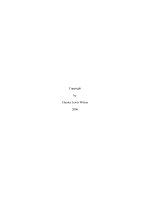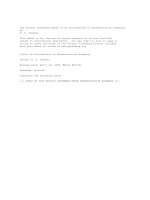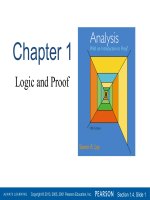Analysis with an introduction to proof 5th by steven lay ch05b
Bạn đang xem bản rút gọn của tài liệu. Xem và tải ngay bản đầy đủ của tài liệu tại đây (200.42 KB, 12 trang )
Chapter 5
Limits and Continuity
Copyright © 2013, 2005, 2001 Pearson Education, Inc.
Section 5.4, Slide 1
Section 5.4
Uniform Continuity
Copyright © 2013, 2005, 2001 Pearson Education, Inc.
Section 5.4, Slide 2
For a function f : D →
to be continuous on D, it is required that
for every x0 ∈ D and for every ε > 0 there exists a δ > 0 such that
| f (x) – f (x0)| < ε whenever | x – x0 | < δ and x ∈ D.
Note the order of the quantifiers: δ may depend on both ε and the point x0.
If it happens that, given ε > 0, there is a δ > 0 that works for all x0 in D,
then f is said to be uniformly continuous.
Definition 5.4.1
Let f :D →
. We say that f is uniformly continuous on D if
for every ε > 0 there exists a δ > 0 such that | f (x) – f ( y)| < ε
whenever | x – y | < δ and x, y ∈ D .
Copyright © 2013, 2005, 2001 Pearson Education, Inc.
Section 5.4, Slide 3
Example 5.4.2*
We claim that the function f (x) = 3x is uniformly continuous on
.
Given any ε > 0, we want to make | f (x) – f ( y)| < ε by making x sufficiently close to y.
We have
So we may take δ = ε /3.
| f (x) – f ( y)| = | 3x – 3y| = 3| x – y|.
Then whenever | x – y | < δ we have
| f (x) – f ( y)| = 3| x – y| < 3δ = ε.
We conclude that f is uniformly continuous on
Copyright © 2013, 2005, 2001 Pearson Education, Inc.
.
Section 5.4, Slide 4
Example 5.4.4
2
The function f (x) = x is not uniformly continuous on
.
Let’s look at this graphically.
Given a point x1 close to 0 and an
ε -neighborhood about f (x1),
f (x)
f (x) = x
2
the required δ can be fairly large.
But as x increases, the value
f (x2)
of δ must decrease.
This means the continuity is
ε -neighborhood
not uniform.
f (x1)
x1
Copyright © 2013, 2005, 2001 Pearson Education, Inc.
x2
x
Section 5.4, Slide 5
Example 5.4.4
2
The function f (x) = x is not uniformly continuous on
.
As a prelude to proving this, let’s write out the statement of uniform continuity
and its negation.
The function f is uniformly continuous on D if
∀ ε > 0 ∃ δ > 0 such that ∀ x, y ∈ D, | x – y | < δ implies | f (x) – f ( y)| < ε .
So the function f fails to be uniformly continuous on D if
∃ ε > 0 such that
∀ δ > 0,
(Any ε > 0 would work.)
Suppose we take ε = 1.
Now for the proof.
| x – y | < δ and | f (x) – f ( y)| ≥ ε.
∃ x, y ∈ D such that
We must show that given any δ > 0, there exist x, y in
such that | x – y | < δ and
2 2
| f (x) – f ( y)| = | x – y | = | x + y | ⋅ | x – y | ≥ 1.
For any x, if we let y = x + δ /2, then | x – y | = δ /2 < δ .
1 ≤ | x + y| ⋅ | x – y|
we need to have | x + y | ≥ 2/δ .
=
Thus to make
| x + y | ⋅ (δ /2),
This prompts us to let x = 1/δ .
Here is the formal proof.
Copyright © 2013, 2005, 2001 Pearson Education, Inc.
Section 5.4, Slide 6
Example 5.4.4
2
The function f (x) = x is not uniformly continuous on
.
Proof:
Let ε = 1.
Then given any δ > 0, let x = 1/δ and y = 1/δ + δ /2.
Then | x – y | = δ /2 < δ , but
2 2
| f (x) – f ( y)| = | x – y | = | x + y | ⋅ | x – y |
=
Thus f is not uniformly continuous on
Copyright © 2013, 2005, 2001 Pearson Education, Inc.
1 1 δ δ 2 δ
+ +
> ÷ ÷ = 1.
δ δ 2 2 ÷
δ 2
.♦
Section 5.4, Slide 7
Example 5.4.5*
2
The function f (x) = x is uniformly continuous on D if D is a bounded set.
For example, let D = [– 3, 3].
Then | x + y | ≤ 6.
So given ε > 0, if δ = ε /6 and | x – y | < δ , we have
2 2
| f (x) – f ( y)| = | x – y | = | x + y | ⋅ | x – y |
≤ 6| x – y | < 6δ = ε .
This is a special case of the following theorem.
Copyright © 2013, 2005, 2001 Pearson Education, Inc.
Section 5.4, Slide 8
Theorem 5.4.6
Suppose f : D →
is continuous on a compact set D. Then f is uniformly
continuous on D.
Proof:
Let ε > 0 be given. Since f is continuous on D, f is continuous at each x ∈ D.
Thus for each x ∈ D, there exists a δ > 0 such that
x
| f (x) – f ( y)| < ε /2
whenever | x – y | < δ
Now the family of neighborhoods F
Since D is compact, F contains a finite subcover.
That is, there exist x1, …, xn in D such that
{ δ x / 2, K , δ x / 2} .
Now let δ = min
1
n
and y ∈ D.
δ
= N x ; x ÷: x ∈ D
2
δ x1
D ⊆ N x1 ;
2
is an open cover of D.
δ xn
÷∪ L ∪ N xn ;
2
÷.
If x, y ∈ D with | x – y | < δ , then it can be shown
(in the book) that there is some index i such that
Open cover of D
x
| x − xi | < δ xi and | y − xi | < δ xi .
It follows that | f (x) – f (x )| < ε /2 and | f ( y) – f (x )| < ε /2,
i
i
so that | f (x) – f ( y)| ≤ | f (x) – f (x )| + | f (x ) – f ( y)|
i
i
< ε /2 + ε /2 = ε. ♦
D
Copyright © 2013, 2005, 2001 Pearson Education, Inc.
Section 5.4, Slide 9
How does uniform continuity relate to sequences?
Recall that the continuous image of a convergent sequence need not be convergent
if the limit of the sequence is not in the domain of the function.
For example, let f (x) = 1/x and xn = 1/n.
Then (xn) converges to 0, but since f (xn) = n for all n,
the sequence ( f (xn)) diverges to + ∞.
But with uniform continuity we have the following:
Theorem 5.4.8
Let f : D →
be uniformly continuous on D and suppose that (xn) is a Cauchy
sequence in D. Then ( f (xn)) is a Cauchy sequence.
Proof:
Given any ε > 0, since f is uniformly continuous on D there exists a δ > 0 such that
| f (x) – f ( y)| < ε whenever | x – y | < δ and x, y ∈ D.
Since (xn) is Cauchy, there
exists N ∈
such that | xn – xm | < δ whenever m, n ≥ N.
Thus for m, n ≥ N we have | f (xn) – f ( xm)| < ε , so ( f (xn)) is Cauchy. ♦
Copyright © 2013, 2005, 2001 Pearson Education, Inc.
Section 5.4, Slide 10
Using Theorem 5.4.8 we can derive a useful test to determine if a function is uniformly
continuous on a bounded open interval.
~
f
We say that a function
~
f
f (x) =
:E→
is an extension of f : D →
if D ⊆ E and
(x) for all x ∈ D.
Theorem 5.4.9
A function f : (a, b) →
~
f
to a function
is uniformly continuous on (a, b) iff it can be extended
that is continuous on [a, b].
Proof:
~
If f can be extended to a function
f
~
f
It follows that
then
that is continuous on the compact set [a, b],
is uniformly continuous on [a, b] by Theorem 5.4.6.
~
f f ) is also uniformly continuous on the subset (a, b).
(and hence
Copyright © 2013, 2005, 2001 Pearson Education, Inc.
Section 5.4, Slide 11
Theorem 5.4.9
A function f : (a, b) →
~
f
to a function
is uniformly continuous on (a, b) iff it can be extended
that is continuous on [a, b].
Proof:
Conversely, suppose that f is uniformly continuous on (a, b).
We claim that lim → f (x) and lim → f (x) both exist as real numbers.
x a
x b
To see this, let (sn) be a sequence in (a, b) that converges to a.
Then (sn) is Cauchy, so Theorem 5.4.8 implies that ( f (sn)) is also Cauchy.
Theorem 4.3.12 then implies that ( f (sn)) converges to some real number, say p.
It follows (Theorem 5.1.10) that lim → f (x) = p.Similarly, we have
x a
Now define
lim → f (x) = q, for some real number q.
x b
~
f (x) =
f (x)
if a < x < b,
p
if x = a,
q
But
by
~
Then
is an
f extension of f .
Since f is continuous on (a, b), so is
if x = b.
~
is falso continuous at a and b, so
~
: [a, b] →
f
.
~
f
~
is continuous on [a, b]. ♦ f
Copyright © 2013, 2005, 2001 Pearson Education, Inc.
Section 5.4, Slide 12









